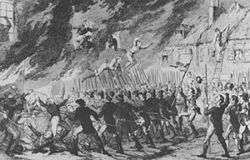23 May 1798: The Battle of Prosperous and the outbreak of the Rising of 1798.
The Rising was fixed for the night of 23rd May 1798. The signal was to be the simultaneous stopping of the mail coaches that left Dublin General Post Office daily for Belfast, Cork, Athlone and Limerick. On the 23rd of May the mail coaches were to be seized and burnt at Santry, Naas, Lucan and the Curragh, and the rising began.
In the City itself attempts to trigger an outbreak were thwarted as the British Army moved to seize strategic assembly points and thus nip things in the bud. Small crowds of men had set out from the poor districts of the city of Dublin to seize the Castle and other key public buildings. Agents of the Crown had infiltrated their revolutionary organization, the United Irishmen, and had already arrested several of their key leaders, Lord Edward FitzGerald being the most important of them.
The Militia mobilized before the revolutionaries could assemble in large groups and what their leaders had hoped would be an almost bloodless coup turned into a debacle. Outside the City though the insurgents fared better and many gathered in rural areas of County Dublin as well as southern County Meath, northern County Kildare and northern and western County Wicklow. These groups attacked towns and villages in their respective localities and stopped and destroyed some of the mail coaches that were making their way out to the provinces.
From 24 May there was fighting at Prosperous, Clane, Kilcock, Maynooth, Rathangan, Timahoe, Monasterevan, and other places.
But it was at Prosperous, Co Kildare that the first military engagement began at 2 a.m on 24 May 1798 by a United Irishmen force about 600+ strong which targeted the British garrison consisting of Cork militia and a detachment of a Welsh regiment, the "Ancient Britons".
The garrison consisted of 35 of the City of Cork militia and 22 ancient Britons who were housed separately near the barracks. Captain Richard Longford Swayne, commander of the militia, had terrorised the area at free-quarters, since his arrival on the 20th May. Throughout Wednesday the 23rd, the locals gathered in the woods. At 2 o' clock the following morning, around 500 of them under Dr. John Esmond and Andrew Farrell. Their entry into the town was preceded by the infiltration of a small vanguard who, possibly aided by female sympathisers within, scaled the walls of the Militia barracks, killed the sentries and opened the gate.
At the barracks, they forced their way into Swayne's quarters where he was piked and shot before the troops could secure the building. Lighted faggots and furze were thrown through the windows of the underground office and the barracks was engulfed. Many of those who tried to escape were piked to death in the streets. Of the 57 soldiers in the garrison, nearly 40 were killed. Swayne's body was burnt in a tar barrel.
Thus was gained the first victory over the hated forces of the British Government.
But the next day, other members of the Ancient Britons, hearing of the death of their fellow soldiers, participated in the retaliatory massacre of 34 Irish prisoners at Dunlavin Green, Co. Wicklow.
Prosperous remained under United Irishmen control until 19 June when it was retaken by troops under the command of Colonel Stewart who boasted of destroying "this receptacle of rebellion".
By the end of the Summer of 1798 some 25,000 - 30,000 people lay dead across 11 counties of Ireland and the Rising was Crushed.

No comments:
Post a Comment